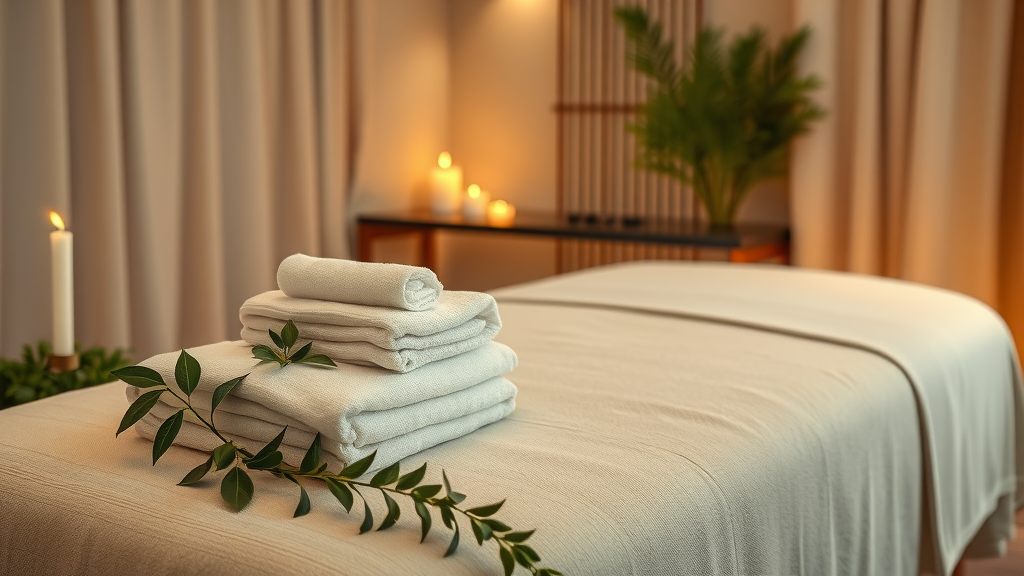Imagine sinking into a world crafted just for you—where every detail is designed to rejuvenate your spirit, restore your energy, and elevate joyfulness. For today’s woman, prioritizing wellness isn’t a luxury—it's a necessity. Spas and wellness for joyfulness aren’t simply about beauty; they are sanctuaries of transformation, where you can shed stress, embrace sisterhood, and unlock true bliss. Get ready to discover how these vibrant havens nurture your mind and body, guiding you toward a life radiant in joy and well-being.
Discover Spas and Wellness for Joyfulness: A Path to Vibrant Living
In the heart of every woman lies a profound desire for meaning, tranquility, and joy—a desire that modern life too often overlooks. Choosing spas and wellness for joyfulness as part of your wellness journey offers a powerful antidote to daily stress, empowering you to thrive in mind and body. Today’s top wellness retreats—like Loma de Vida and Miraval Berkshires—offer more than spa treatments; they invite you to rewrite your story, to reconnect with nature, and to rediscover what it means to truly flourish.
From invigorating hot springs to holistic body treatments and inclusive packages crafted for women, these sanctuaries go above and beyond the ordinary spa experience. Whether your goal is to nurture your soul, spark connections with other women, or indulge in thoughtfully curated experiences, you’ll find countless offerings tailored for your well-being. The path to vibrant living—anchored in spas and wellness for joyfulness—is not just accessible but essential for every woman striving to become the best version of herself.
"Every woman deserves a sanctuary—a place for restoring mind, body, and joy."

What You'll Learn about Spas and Wellness for Joyfulness
- How spas and wellness for joyfulness empower women's well-being
- Unique benefits of a wellness retreat
- Signature wellness experiences like Loma de Vida and Miraval Berkshires
- Cost considerations for popular spa destinations
- Frequently asked questions to help you choose the perfect fit
Embracing Spas and Wellness for Joyfulness: Why Women Need Sanctuary
The stressors of modern womanhood—balancing work, relationships, and responsibilities—weigh heavily on both mind and body. That’s why women need sanctuaries where wellness and joyfulness are not only restored but celebrated. Spas and wellness for joyfulness aren’t about escaping life—they're about enriching it. Wellness retreats surround you with tranquility, support systems, and expert guidance, helping you rekindle your inner spark in inspiring outdoor adventure settings and mindful environments.
These sanctuaries offer thoughtful spa amenities and body treatments designed to empower women at any stage of their wellness journey. From steam rooms and yoga practice studios to lush hot springs, every moment at a spa is an opportunity to foster lasting joy and transformation. Specialists in these exclusive wellness centers understand the nuances of women’s health, making it possible for you to restore balance, confidence, and authentic connection.
Emotional and Physical Benefits of Wellness Retreats
- Relieving stress and anxiety
- Restoring hormonal balance
- Fostering connections with other women
Participating in a wellness retreat renews your sense of self on many levels. Emotional fatigue and anxiety give way to calm through mindful meditation, personalized massage therapies, and nourishing surroundings. The expert spa menu and salon services are tailored to meet the unique needs of women, supporting both individual and collective well-being. As cortisol drops and serotonin rises, your body and mind realign, making space for true joyfulness.
Perhaps most importantly, these environments cultivate connection. Meeting women who share your journey—whether during group body treatments, fitness classes, or around a communal hot spring—nurtures camaraderie and kinship. This sense of belonging, paired with levels of relaxation only a thoughtfully curated wellness retreat can provide, leads to deep and lasting transformation.

Choosing the Right Spas and Wellness for Joyfulness—A Guide to Wellness Retreats
Not all wellness retreats are created equal. Spas and wellness for joyfulness should be as individualized as you are, with each detail—from spa menu to retreat package—designed to support your unique wellness goals and joyful living. Key elements like location, treatment variety, and inclusive packages define the experience and impact your ultimate sense of fulfillment.
The most renowned retreats offer a variety of spa services, from hot springs to deep tissue massages and mindful movement exercises. They also provide full access to amenities such as fitness studios, outdoor adventure trails, and specialized women’s wellness workshops. Consider spas like Loma de Vida and Miraval Berkshires for their transparent pricing, holistic programming, and reputation for transforming lives through wellness experiences that spark true joyfulness.
Key Factors in Selecting a Wellness Retreat
- Location: hot springs, natural beauty, accessibility
- Program offerings: yoga, mindfulness, spa treatment, outdoor adventure
- Inclusive packages and pricing transparency
When researching your ideal spa or wellness retreat, focus on setting. Retreats that incorporate nature—hot springs, lush gardens, or panoramic hilltops like Loma de Vida—tend to offer deeper relaxation and ongoing joyfulness long after you return home. Program diversity is also crucial: choose locations that offer fitness classes, mindful meditation, and body treatments alongside more traditional spa services. Finally, clarity in pricing ensures you know exactly what you are investing in, allowing for peace of mind and a focus on joyful transformation.
By aligning your personal preferences with these criteria, you ensure each moment at your chosen retreat maximizes your wellness journey. When you finally step into that steam room or outdoor adventure trail, you’ll know you’ve chosen a sanctuary that’s truly dedicated to nurturing your mind and body.
Exploring Signature Wellness Experiences: Loma de Vida, de Vida, and Miraval Berkshires
Signature experiences are the heartbeat of every remarkable wellness retreat. Locations like Loma de Vida, de Vida, and Miraval Berkshires have redefined the standards for women’s wellness, merging tradition with innovation for transformative outcomes. These destinations are crafted for those seeking joyfulness, meaningful connection, and a deeper understanding of wellness.
Each property blends scenery, expert treatments and services, and innovative programming to offer a transformative experience beyond a standard spa day. With thoughtfully curated options spanning outdoor adventure, mindful movement, and spa amenities, these signature locations empower women to explore every layer of well-being—mind, body, and spirit.
Loma de Vida: A Transformative Journey
- Award-winning spa treatments
- Mind and body rejuvenation
- Outdoor adventure settings
Nestled on a stunning hilltop, Loma de Vida is a beacon for transformative wellness journeys. Known for its award-winning body treatments and spa services, it caters specifically to women seeking mind and body renewal in nature. Outdoor adventure amenities—including guided hikes and meditative outdoor yoga practice—add excitement and inspiration to each guest’s stay.
Guests relish the full access to thoughtfully designed spa amenities, steam rooms, and tranquil outdoor spaces. Staff at Loma de Vida are adept at personalizing your experience—whether it’s a deep massage therapy session or a moonlit soak in a private hot spring. Every detail is centered around your joyfulness, creating profound shifts you’ll carry long after your visit.

De Vida: Immersive Wellness Programs for Lasting Joyfulness
- Cultural healing rituals
- Nature-inspired therapies
De Vida stands out for its deep reverence for cultural healing and holistic well-being. The retreat offers a spectrum of nature-inspired therapies—ranging from ancient energy balancing to signature spa menu treatments—infusing each moment with tradition and purpose. Guests are immersed in practices that honor both modern science and ageless wisdom, fostering a sense of lasting joyfulness.
Participate in group mindful meditation or solo body treatments, or reconnect with your inner self in harmony with both community and nature. Each thoughtfully curated program is designed to give women of all years of age the space to evolve, celebrate, and leave with a renewed sense of belonging and confidence.
Miraval Berkshires: Unwinding in the Lap of Luxury
- All-inclusive package experiences
- Special women-focused programs
Miraval Berkshires is synonymous with luxury wellness. Its renowned all-inclusive packages merge five-star lodging, nutritious gourmet meals, and daily spa treatments in one cohesive wellness journey. The retreat’s unique focus on women’s empowerment is woven into everything from curated workshops to personalized fitness classes and body treatments. For women seeking true escape and sophisticated self-care, Miraval delivers at every turn.
Dedicated practitioners use cutting-edge techniques while respecting ancient healing art forms, ensuring every wellness experience—from mindful movement to outdoor adventure—is memorable. Whether you seek spa treatment, a connection with like-minded women, or a new fitness routine, Miraval Berkshires goes beyond expectations, equipping guests with joyful strategies for a balanced and meaningful life.
Wellness Experiences for Women: From Hot Springs to Spa Treatment
Women’s wellness flourishes in environments where body, mind, and community unite. Spa and wellness experiences now offer an even broader spectrum of options, from steaming hot springs to signature spa treatment packages infused with mindful healing. Each thoughtfully curated experience opens doors to new levels of relaxation, energy, and self-knowledge.
Whether your perfect day involves a soak in healing mineral waters, a gentle yoga practice, or salon services and massage, embracing a diversity of wellness experiences ensures transformation from within. Retreats offer a variety of specialty treatments—all designed to guide you toward true bliss and vibrant health.
Nature-Based Hot Springs for Renewed Energy

Few experiences rival the restorative power of hot springs. Spas that feature natural mineral pools offer both physical and emotional healing. The minerals in these waters work in harmony with nature to soothe tired muscles, enhance circulation, and leave your skin glowing. For women, this immersion is about more than relaxation—it’s about tapping into a deeper state of joyfulness and self-worth.
At leading wellness retreats, guests can mingle around alpine hot springs, bask in sunbeams, and savor the tranquility of mountain landscapes. These moments build lasting memories, facilitate new connections, and renew the energy essential for achieving wellness goals. It’s a truly holistic offering, combining body treatments with breathtaking natural beauty.
Signature Spa Treatment Packages for Mind and Body
The right collection of body treatments forms the backbone of transformative spa experiences. From customized massage therapies and invigorating skin therapies to expertly guided mindful movement, each treatment is designed to nurture both mind and body. Leading retreats offer a spa menu rich in choices, ensuring that every guest finds the perfect combination for her unique wellness journey.
Comprehensive packages often include full access to spa amenities—steam rooms, serene lounges, and outdoor spaces—complementing your body treatments with every luxury imaginable. These all-encompassing experiences, combined with group fitness classes, guarantee women of all years or older can discover new facets of joyfulness.
Financial Wellness: How Much Does It Cost to Stay at Miraval?
Investing in your wellness journey is a meaningful commitment to your future well-being. The cost to stay at leading retreats like Miraval Berkshires and Loma de Vida varies by season, package, and amenities, but inclusive packages ensure you receive maximum value from every dollar spent—lodging, meals, spa services, and transformative experiences are bundled for seamless joyfulness.
Consider your unique needs: Do you want a standard retreat package with à la carte spa treatments or a full inclusive package with spa credits, fitness classes, body treatments, and culinary delights? Use the table below to compare options so you can choose the best fit for your wellness goals.
| Retreat | Package Type | Cost Range (per night) | Included Amenities |
|---|---|---|---|
| Miraval Berkshires | All-Inclusive | $650-$1,200 | Lodging, Meals, Activities, Spa Credits |
| Loma de Vida | Standard/Inclusive | $450-$900 | Accommodation, Access to Facilities, Treatments (à la carte) |

People Also Ask: Spa and Wellness Retreat FAQs
How much does it cost to stay at Miraval?
Miraval Berkshires pricing varies by season and package, ranging from about $650 to $1,200 per night inclusive of lodging, meals, and activity credits.
Are wellness retreats worth the cost?
Many women find that wellness retreats like spas and wellness for joyfulness are invaluable investments in mental, emotional, and physical health, offering much more than just relaxation.
What's the difference between a spa and a wellness center?
Spas focus on relaxation treatments such as massages and facials, while wellness centers—often part of wellness retreats—offer holistic programs, fitness, nutrition, and mind-body therapies.
What is Miraval Berkshires known for?
Miraval Berkshires is renowned for its holistic wellness experiences, inclusive packages, pioneering mindfulness programs, and women-empowerment initiatives.
Key Takeaways: Spas and Wellness for Joyfulness Transform Lives
- Tailored wellness retreats nurture joyfulness and boost women's health
- Signature locations like Loma de Vida and Miraval Berkshires offer unique benefits
- Investment in a wellness retreat provides long-lasting joy and balance

Your Pathway to Joy: How to Book Spas and Wellness for Joyfulness Now
- Research preferred wellness retreat destinations
- Compare inclusive package offers
- Contact the spa or use online booking for seamless reservations
Taking the first step toward true joyfulness is easier than ever. Whether you are a first-time guest or a returning spa enthusiast, your pathway to transformation begins with a single decision—prioritizing yourself. Identify your favorite retreats, compare their packages, and reach out to secure the experience that will redefine the way you feel, connect, and live.
Frequently Asked Questions on Spas and Wellness for Joyfulness
- Which wellness experiences are best for first-timers?
- Look for retreats offering introductory spa treatment packages—yoga, massage, and guided meditation are excellent choices.
- How can I maximize joyfulness during my retreat?
- Participate fully, make time for both solo reflection and group activities, and let go of outside distractions to anchor more deeply in the present.
- What preparation is needed before attending a spa or wellness center?
- Set wellness goals, pack comfortable attire, and communicate preferences or limitations to spa staff to ensure a tailored experience.
Begin Your Journey: Subscribe for Empowered Women's Wellness and Joyfulness
- Subscribe for more strategies on how to be a successful woman in every area of your life: http://spotlightonyoursuccess.com
Ready to transform your life? Let spas and wellness for joyfulness be your sanctuary for lasting joy and empowered living—start your journey today!
 Add Row
Add Row  Add
Add 




Write A Comment